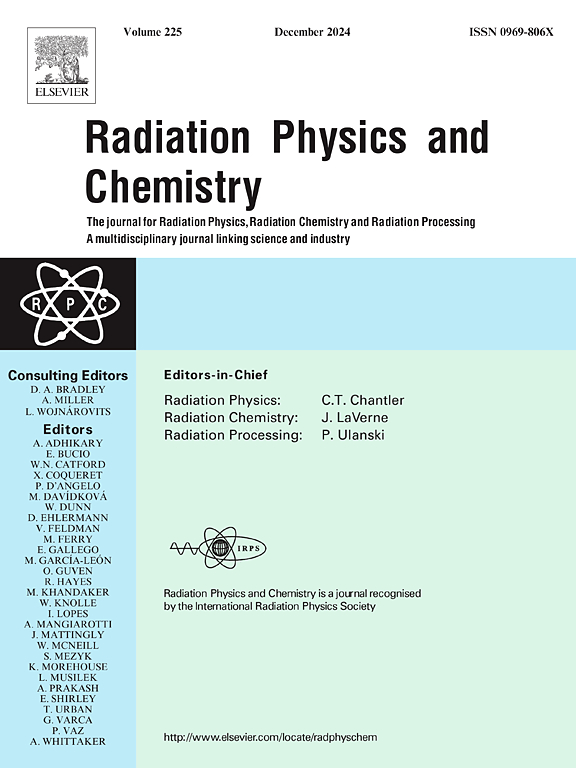Development of metal/metal oxide enriched polymer composites for radiation shielding of low-energy photons
IF 2.8
3区 物理与天体物理
Q3 CHEMISTRY, PHYSICAL
引用次数: 0
Abstract
Increasing applications of ionizing radiation in medical and industrial processes indicate a growing demand for effective radiation shielding materials that are non-toxic and recyclable. Specific radiation–resistant, lead-free, lightweight shielding materials are required to protect personnel and patients against medical radiation since lead toxicity poses significant environmental and health risks and problems with lead utilization.
In this study 1.0 mm thick PVA polymer composite films containing 50 V/V% of different fillers (Tungsten (VI) oxide (WO3), Tantalum (V) oxide (Ta2O5), Tin (Sn), and Bismuth (Bi)) were fabricated and tested for radiation attenuation performance using Multimeter Barracuda with R100B detector (RTI Electronics AB, Sweden). Irradiation of films with low energy photons was performed in X-ray therapy unit GULMAY D3225 (UK). Irradiation of samples in Leksell Gamma Knife® Icon™ (Elekta, Sweden), and linear accelerator Varian Trilogy™ (California, USA) providing MeV range photons was performed additionally for the assessment of correlations between experimental data and modeling results in the broad energy range.
Photon attenuation and shielding efficiency of fabricated experimental samples: single-filled (PVA-WO3, PVA-Ta2O5, PVA-Sn, and PVA-Bi) and dual-filled (PVA-Bi-WO3, PVA-Ta2O5-WO3, PVA-Sn-WO3, PVA-Bi-Ta2O5, PVA-Sn-Ta2O5, PVA-Bi-Sn) polymer composites were assessed using experimental measurements data. Experimental results were verified against simulation data obtained using open-access software Phy-X/PSD and compared with the data corresponding to 0.25 and 0.5 mmPb lead equivalent as reference of required medical radiation shielding equipment.
It was shown that single filler PVA-Bi and dual-filler with WO3–Bi composites exhibited the highest radiation shielding efficiency in the low energy range and at certain energies were performing better than 0.25 mm Pb equivalency, indicating composites‘ potential to be explored in lead-free, lightweight, low-toxicity medical radiation shielding equipment.
Obtained results suggest that PVA-metal/metal oxide composites, especially those with bismuth and tungsten, are promising candidates for environmentally sustainable radiation shielding.
求助全文
约1分钟内获得全文
求助全文
来源期刊

Radiation Physics and Chemistry
化学-核科学技术
CiteScore
5.60
自引率
17.20%
发文量
574
审稿时长
12 weeks
期刊介绍:
Radiation Physics and Chemistry is a multidisciplinary journal that provides a medium for publication of substantial and original papers, reviews, and short communications which focus on research and developments involving ionizing radiation in radiation physics, radiation chemistry and radiation processing.
The journal aims to publish papers with significance to an international audience, containing substantial novelty and scientific impact. The Editors reserve the rights to reject, with or without external review, papers that do not meet these criteria. This could include papers that are very similar to previous publications, only with changed target substrates, employed materials, analyzed sites and experimental methods, report results without presenting new insights and/or hypothesis testing, or do not focus on the radiation effects.
 求助内容:
求助内容: 应助结果提醒方式:
应助结果提醒方式:


